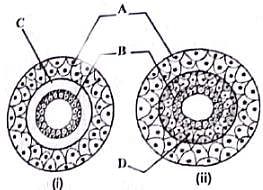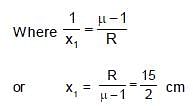NEET Part Test - 5 - NEET MCQ
30 Questions MCQ Test NEET Mock Test Series 2025 - NEET Part Test - 5
A uniform, horizontal parallel beam of light is incident upon a prism as shown. The prism is in the shape of a quarter cylinder, of radius R = 5 cm, and has the index of refraction n = 5/3. The width of the region at which the incident rays after normal incidence on plane surface and subsequent refraction at curved surface intersect on x axis is (Neglect the ray which travels along x-axis as shown in figure)

| 1 Crore+ students have signed up on EduRev. Have you? Download the App |
Thylakoids possessing four types of major complexes have their membranes made up of both proteins and unsaturated lipids. Which of the following complexes is/are evenly distributed in the stroma and granal thylakoids?
a. Photosystem I
b. Photosystem II
c. Cyt b6-f complex
b. Photosystem II
c. Cyt b6-f complex
How many ATPs are required by C4 plants in synthesis of one molecule of glucose
Which one of the following is a matching set of a phylum and its three examples?
Bilateral symmetry, metameric segmentation, coelom and open circulatory system chiaracterizes which of the following phylum?
Which one of the following statements about certain given animals is correct?
In which of the following, segmentation in the body is first observed?
Among the following organisms which is a completely non-parasitic form?
Consider the following statements (A - C) each with two blanks.
A. Animals like Hydra and Jelly fish depict (i) symmetry whereas all vertebrates show (ii) symmetry.
B. In fiii) and (iv) digestive tract has only sngle opening (mouth) and is said to be incomplete.
C. Trichinella (Trichina worm) is a cosmopolitan (v) parasite whereas Fasciola (liver fluke) lives in the ducts of the liver of (vi)
Which one of the following options, gives the correct fill ups for the respective blank numbers from (i) to (vi) in the statements?
Read the given statements and select the correct option.
Statement 1: All triploblastic animals are eucoelomates.
Statement 2: They have a false coelom.
Examine the figures of diploblastic (i) and triploblastic (ii) organization in animals given below and identify the labelled parts A to D.

The synthesis of complex organic substances from simple inorganic raw materials in the presence of sunlight and chlorophyll is called ..........., which is a ............ process.
Visible part of electromagnetic spectrum consists of radiations having a wavelength in the range of
Assertion: Many visitors to the hills suffer from skin and respiratory allergy problems.
Reason: Conifer trees produce a large quantity of wind-borne pollen grains.
AIDS is caused by Human immuno deficiency virus (HIV) which is a member of group of virus called?
The enzyme that interconnects the glycolysis and kreb cycle is:
Which of the following statements are correct?
(A) The oxidation of pyruvic acid molecules formed in glycolysis occurs inside the mitochondria.
(B) Acetyl CoA is a 3-carbon compound.
(C) Under anaerobic conditions, the pyruvic acid formed during glycolysis is reduced to either ethyl alcohol or lactic acid.
(D) Acetyl CoA molecules enter into cyclic reactions during Calvin cycle.
Dough kept overnight in warm place becomes soft and spongy due to:
Which of the following reactions is catalysed by the enzyme phosphofructokinase?
Which period of menstrual cycle is called the risky period of conception?
Identify the intra-uterine contraceptive device from the figure given below
|
1 videos|26 docs|111 tests
|
|
1 videos|26 docs|111 tests
|




 . the rays above the ray incident on curved surface at i = 370 shall suffer TIR and need not be considered.
. the rays above the ray incident on curved surface at i = 370 shall suffer TIR and need not be considered.


















